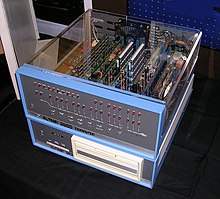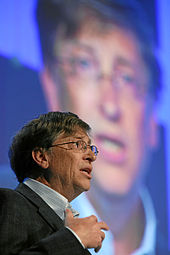At 13, he enrolled in the Lakeside School, a private preparatory school.[26] When he was in the eighth grade, the Mothers Club at the school used proceeds from Lakeside School's rummage sale to buy a Teletype Model 33 ASR terminal and a block of computer time on a General Electric (GE) computer for the school's students.[27] Gates took an interest in programming the GE system in BASIC, and was excused from math classes to pursue his interest. He wrote his first computer program on this machine: an implementation of tic-tac-toe that allowed users to play games against the computer. Gates was fascinated by the machine and how it would always execute software code perfectly. When he reflected back on that moment, he said, "There was just something neat about the machine."[28] After the Mothers Club donation was exhausted, he and other students sought time on systems including DEC PDP minicomputers. One of these systems was a PDP-10 belonging to Computer Center Corporation (CCC), which banned four Lakeside students – Gates, Paul Allen, Ric Weiland, and Kent Evans – for the summer after it caught them exploiting bugs in the operating system to obtain free computer time.[29][30]
At the end of the ban, the four students offered to find bugs in CCC's software in exchange for computer time. Rather than use the system via Teletype, Gates went to CCC's offices and studied source code for various programs that ran on the system, including programs in Fortran, Lisp, and machine language. The arrangement with CCC continued until 1970, when the company went out of business. The following year, Information Sciences, Inc. hired the four Lakeside students to write a payroll program in Cobol, providing them computer time and royalties. After his administrators became aware of his programming abilities, Gates wrote the school's computer program to schedule students in classes. He modified the code so that he was placed in classes with "a disproportionate number of interesting girls."[31] He later stated that "it was hard to tear myself away from a machine at which I could so unambiguously demonstrate success."[28] At age 17, Gates formed a venture with Allen, called Traf-O-Data, to make traffic counters based on the Intel 8008 processor.[32] In early 1973, Bill Gates served as a congressional page in the U.S. House of Representatives.[33]
Gates graduated from Lakeside School in 1973, and was a National Merit Scholar.[34] He scored 1590 out of 1600 on the SAT[35] and enrolled at Harvard College in the autumn of 1973.[36] While at Harvard, he met Steve Ballmer, who would later succeed Gates as CEO of Microsoft.[37]
The Poker Room in Currier House at Harvard College
Gates did not have a definite study plan while a student at Harvard[41] and spent a lot of time using the school's computers. Gates remained in contact with Paul Allen, and he joined him at Honeywell during the summer of 1974.[42] The following year saw the release of the MITS Altair 8800 based on the Intel 8080 CPU, and Gates and Allen saw this as the opportunity to start their own computer software company.[43] Gates dropped out of Harvard at this time. He had talked this decision over with his parents, who were supportive of him after seeing how much Gates wanted to start a company.[41]
Microsoft
Main articles: History of Microsoft and Microsoft
BASIC
MITS Altair 8800 Computer with 8-inch (200 mm) floppy disk system
Microsoft's Altair BASIC was popular with computer hobbyists, but Gates discovered that a pre-market copy had leaked into the community and was being widely copied and distributed. In February 1976, Gates wrote an Open Letter to Hobbyists in the MITS newsletter in which he asserted that more than 90% of the users of Microsoft Altair BASIC had not paid Microsoft for it and by doing so the Altair "hobby market" was in danger of eliminating the incentive for any professional developers to produce, distribute, and maintain high-quality software.[46] This letter was unpopular with many computer hobbyists, but Gates persisted in his belief that software developers should be able to demand payment. Microsoft became independent of MITS in late 1976, and it continued to develop programming language software for various systems.[45] The company moved from Albuquerque to its new home in Bellevue, Washington, on January 1, 1979.[44]
During Microsoft's early years, all employees had broad responsibility for the company's business. Gates oversaw the business details, but continued to write code as well. In the first five years, Gates personally reviewed every line of code the company shipped, and often rewrote parts of it as he saw fit.[47]
IBM partnership
IBM approached Microsoft in July 1980, regarding its upcoming personal computer, the IBM PC.[48] The computer company first proposed that Microsoft write the BASIC interpreter. When IBM's representatives mentioned that they needed an operating system, Gates referred them to Digital Research (DRI), makers of the widely used CP/M operating system.[49] IBM's discussions with Digital Research went poorly, and they did not reach a licensing agreement. IBM representative Jack Sams mentioned the licensing difficulties during a subsequent meeting with Gates and told him to get an acceptable operating system. A few weeks later, Gates proposed using 86-DOS (QDOS), an operating system similar to CP/M that Tim Paterson of Seattle Computer Products (SCP) had made for hardware similar to the PC. Microsoft made a deal with SCP to become the exclusive licensing agent, and later the full owner, of 86-DOS. After adapting the operating system for the PC, Microsoft delivered it to IBM as PC DOS in exchange for a one-time fee of $50,000.[50]Gates did not offer to transfer the copyright on the operating system, because he believed that other hardware vendors would clone IBM's system.[50] They did, and the sales of MS-DOS made Microsoft a major player in the industry.[51] Despite IBM's name on the operating system the press quickly identified Microsoft as being very influential on the new computer. PC Magazine asked if Gates were "the man behind the machine?",[48] and InfoWorld quoted an expert as stating "it's Gates' computer".[52] Gates oversaw Microsoft's company restructuring on June 25, 1981, which re-incorporated the company in Washington state and made Gates President of Microsoft and the Chairman of the Board.[44]
Windows
Microsoft launched its first retail version of Microsoft Windows on November 20, 1985, and in August, the company struck a deal with IBM to develop a separate operating system called OS/2. Although the two companies successfully developed the first version of the new system, mounting creative differences caused the partnership to deteriorate.[53]Management style
Bill Gates in January 2008
As an executive, Gates met regularly with Microsoft's senior managers and program managers. Firsthand accounts of these meetings describe him as verbally combative, berating managers for perceived holes in their business strategies or proposals that placed the company's long-term interests at risk.[56][57]
He has interrupted presentations with such comments "That's the stupidest thing I've ever heard!"[58] and, "Why don't you just give up your options and join the Peace Corps?"[59] The target of his outburst then had to defend the proposal in detail until, hopefully, Gates was fully convinced.[58] When subordinates appeared to be procrastinating, he was known to remark sarcastically, "I'll do it over the weekend."[60][61][62]
Gates's role at Microsoft for most of its history was primarily a management and executive role. However, he was an active software developer in the early years, particularly on the company's programming language products. He has not officially been on a development team since working on the TRS-80 Model 100,[63] but wrote code as late as 1989 that shipped in the company's products.[61] On June 15, 2006, Gates announced that he would transition out of his day-to-day role over the next two years to dedicate more time to philanthropy. He divided his responsibilities between two successors, placing Ray Ozzie in charge of day-to-day management and Craig Mundie in charge of long-term product strategy.[64]





Post a Comment